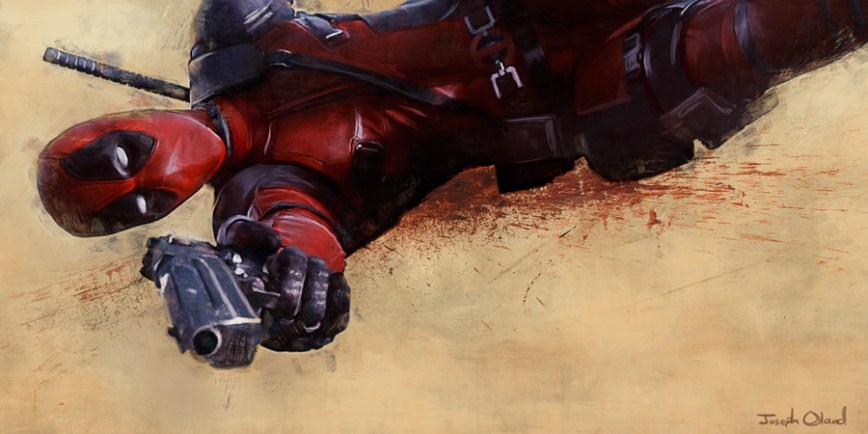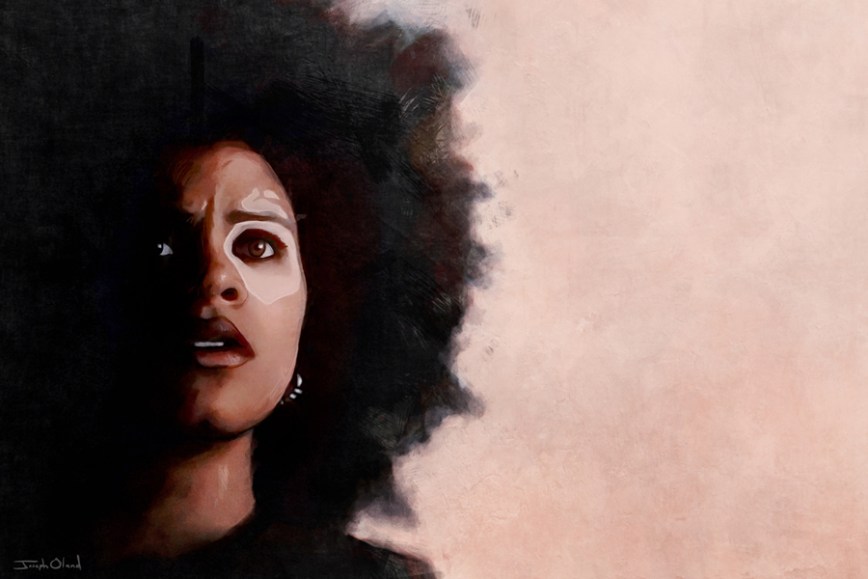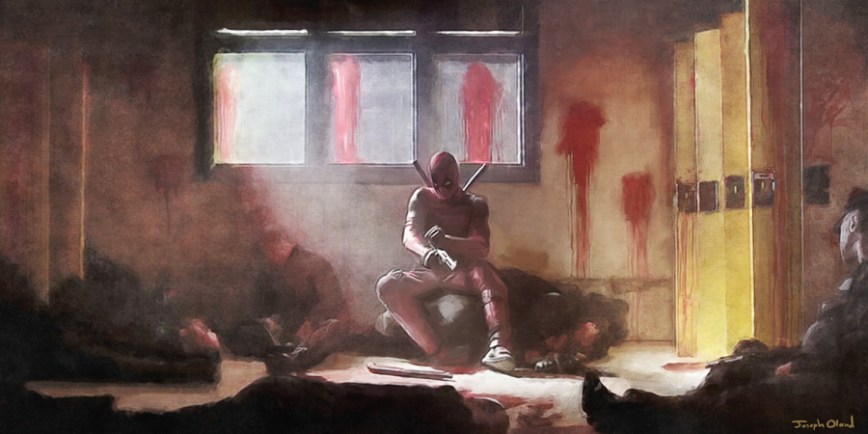
FINE ART PRINTS AVAILABLE HERE
Marvel and DC have mapped-out a half-decade of comic book movies. The market is saturated. Superhero movies are way overdue for self-satire and tonal variation. And that is precisely what we get with “Deadpool,” an incredible breath of fresh air in a crowded arena.
Mainstream reviews of Marvel’s recent release have been mixed, but this isn’t a shocking revelation. The titular character in “Deadpool” isn’t the most accessible – at least not to a broad audience. With self-referential humor, endless threads of inside jokes and constant forth-wall breaks, it takes a genuine fan to fully appreciate this cinematic gem. But a gem indeed it is. Regardless of what the naysayers have published, first-time director Tim Miller has cracked the code of the R-rated comic book movie in stunning fashion. The numbers speak for themselves.
While we have other R-rated movies like “Watchmen,” “300,” and “Sin City,” those are all dark horse examples, and their success remains somewhat questionable. “Deadpool,” on the other hand, is the first R-rated release in the Marvel Cinematic Universe, and this is significant; the success of “Deadpool” will determine whether or not Marvel Studios will roll the dice again. The production is already famously stalwart for facing-down pressure from Twentieth Century Fox to make a PG-13 cut. Larger audiences and a boost to box offices sales is the primary pressure of adventure properties like this (can you imagine what an R-rated “Star Wars” movie could accomplish?), but an R-rating gives directors much more latitide. Tim Miller & Co stood their ground and the gambit is paying off handsomely.
As of this writing, “Deadpool” has already outperformed the previous Thursday box office record for an R-rated feature. In fact, “Deadpool” blew the top spot out of the water. The previous record holder was “Fifty Shades Of Gray,” banking $8.6 million on its Thursday release. One year later, “Deadpool” managed to rake in $12.7 million. This is a coup that nobody predicted. The weekend total is expected to top $123 million, a tall margin ahead of Fox’s $60 million projection.
– – –
“Deadpool” is, at its heart, the smart-ass teenager too clever for his own good, filled with fits of irreverence that hinge on nihilism. He’s been described by some as that kid “who pretends to be too cool to care, but wants you to like him so badly it hurts.” This isn’t an entirely unfair description, and it identifies where the film character is separated from the print character. The comic book anti-hero is a sharp-tongued mercenary anti-hero. The film character is, more or less, a sarcastic hero-hero. He tickles our reptilian brain with slaughter, but he only slaughtering bad guys, and he’s made sympathetic and accessible by the love story that drives the plot forward. These are perfectly acceptable concessions – unavoidable, even – in the superhero movie marketing system. If we elect not to split hairs, “Deadpool” is an incredibly fun movie that brings a larger-than-life personality to the screen with a deep sense of respect for the source material.
The film establishes its irreverent tone straight at the open, with title cards that intentionally mock Hollywood (“Directed By: An Overpaid Tool,” “Produced By: Some Asshats,” “Starring: A Gratuitous Cameo,” “Starring: A CGI Character,” and on and on, to wonderful comic affect), as well as thumbing its nose at The Director’s Guild of America, which has famously sued directors like George Lucas for not crediting the director of “Star Wars” (himself) and “The Empire Strikes Back” (Irvin Kershner).*
After an action sequence opening, most of “Deadpool” plays out in flashback. We learn that Deadpool (Ryan Reynolds) used to be a mercenary named Wade Wilson. We’re introduced to his girlfriend Vanessa (Morena Baccarin) and his best friend Weasel (TJ Miller). Wade and Vanessa are veritable quip-machines, whose quirky and fast-paced humor seem to be the linchpin of future marital bliss. They’re both crazy, and both crazy in love with each other. Then, an unexpected late-stage cancer diagnosis burns the Happily-Every-After to the ground.
A mysterious recruiter gives Wilson an offer he can’t refuse: enlist in the Weapon X program (the same program that created Wolverine), and cure your cancer. Distraught by how his illness is affecting Vanessa, Wilson reluctantly agrees. He is experimented on, and tortured ruthlessly, by a man who calls himself Ajax (Ed Skrein) and his masochistic partner Angel Dust (Gina Carano). He becomes a mutant, with strength and regenerative powers, but is left horribly disfigured. When Ajax leaves him in a burning building, Deadpool begins preparing for his revenge.
Debut director Tim Miller is the head of Blur Studios and is well-equipped to tackle a project like “Deadpool.” His background in animation led to the dazzling title sequence to “The Girl With The Dragon Tattoo” and an astonishingly effective TV spot for the video game “Batman: Arkham Origins.” With a pedigree like that, he has created an energetic movie that vacillates between serious romance/tragedy and humorous (albeit violent) superhero antics. Some may find this manic pacing off-putting, but it effectively balances the action with the slower (and necessary) narrative beats.
Die hard fans may criticize how the film handles the forth-wall breaks, and a sense of humor that could have been more intelligently satirical of the comic book genre. Instead, the humor opts for the faster-paced machine-gunning of smaller meta-jokes. This is a stylistic choice that I think serves the film adequately. More sophisticated satire is better left on the printed page. Some jokes miss their mark, but they’re thrown around so rapidly that it barely matters. Ajax isn’t the most memorable villain, but this, too, is no surprise in a Marvel property; superhero movies seem constitutionally incapable (or unwilling) to spend the necessary time to flesh-out a compelling bad guy.
Weasel is a wonderful pace-shifting character that gives breathing room to the narrative. TJ Miller seems to strike the perfect balance of calm in his scenes, which serve as punctuation marks throughout the story. That being said, Reynolds flat-out owns this film, from beginning to end, leaving little room for the other characters to shine. This isn’t a bad thing; it plants the seeds for future iterations of the “Deadpool” story.
– – –
If you knew who Deadpool was ahead of this weekend’s release, you’re going to love the film. It constantly makes fun of the X-Men franchise that gave birth to the Deadpool character, so it’s fair to say that fans of the franchise are going to “get” the humor. The famously bad Deadpool origin story that was shoe-horned into “Wolverine: Origins” is directly addressed during the film’s opening moments. When dragged away by Colossus (a beautiful motion-capture performance by Stefan Kapicic) to visit Professor X, Deadpool shoots a quick look to the camera and says “McAvoy or Stewart?” referencing the two actors – James McAvoy and Patrick Stewart – who have played the Charles Xavier character in previous X-Men movies. These nods are continuous, warranting multiple viewings, and the post-credit scene at the end of the film (which I will not spoil here) is worth the price of admission all by itself. Anybody outside of the bubble may not understand why the auditorium is erupting with laughter so frequently, and may walk out of the theater scratching their heads.
If you’re a comic book freak, step away from the computer and head straight to the multiplex. It’s worth it.
*George Lucas was fined $250,000 for his transgression, which ultimately led him to resign from the Directors Guild of America. Something tells me Lucas got the last laugh.
FINE ART PRINTS AVAILABLE HERE
SIGN UP FOR THE LENSEBENDER BLOG

The Girl With The Dragon Tattoo

Batman: Arkham Origins
 – – –
– – –





